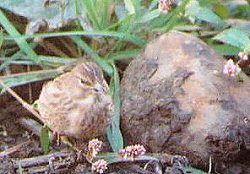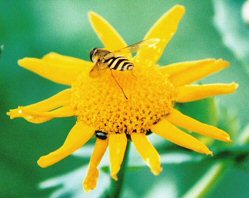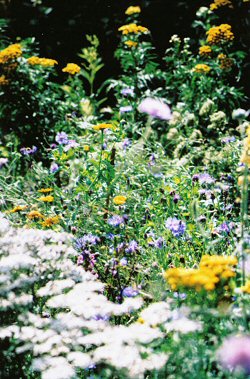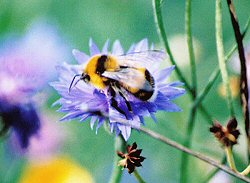| Features: Real Wildlife Gardens |  |
Wildlife gardening from scratch  Peacock (Inachis io), small tortoiseshell (Aglais urticae) and comma (Polygonia c-album) on a butterfly bush (Buddleja davidii).
My partner and I moved to a property on a new housing development in a semi-rural corner of Bishop Auckland in July 2003. The development is ringed by a disused railway line to the east, a farm to the south and west, a small woodland strip running close to the entry of the estate and a major road to the north.
These adjoining areas support wildlife, but Peacock (Inachis io), small tortoiseshell (Aglais urticae) and comma (Polygonia c-album) on a butterfly bush (Buddleja davidii).
My partner and I moved to a property on a new housing development in a semi-rural corner of Bishop Auckland in July 2003. The development is ringed by a disused railway line to the east, a farm to the south and west, a small woodland strip running close to the entry of the estate and a major road to the north.
These adjoining areas support wildlife, but  the housing development itself, with its continuing construction and lawn-based gardens, offered little or nothing to birds and other wildlife the housing development itself, with its continuing construction and lawn-based gardens, offered little or nothing to birds and other wildlife the housing development itself, with its continuing construction and lawn-based gardens, offered little or nothing to birds and other wildlife. We were able only to watch the birds bypass the estate on their flights between the surrounding habitats. The new build provided us with the ideal opportunity to create a garden to our own tastes which would, foremost, make some contribution towards the needs of local wildlife. As the pictures in this article show, we would eventually do just that. the housing development itself, with its continuing construction and lawn-based gardens, offered little or nothing to birds and other wildlife. We were able only to watch the birds bypass the estate on their flights between the surrounding habitats. The new build provided us with the ideal opportunity to create a garden to our own tastes which would, foremost, make some contribution towards the needs of local wildlife. As the pictures in this article show, we would eventually do just that.
Planning the garden An early visitor to the garden; this twite (Acanthis flavirostris) feasted on the seeds of annuals which came in with the topsoil.
We first encountered our modest 100 square metre back garden plot as an area of builders' top soil. Obviously a rich seed bank, the heavy clay quickly began to support an array of irrepressible lush green weeds; predominantly fat hen (Chenopodium album) and redshank (Persicaria maculosa). However, these occupants could support only a limited number of hardy insect species, and other wildlife was depressingly conspicuous by its absence. An early visitor to the garden; this twite (Acanthis flavirostris) feasted on the seeds of annuals which came in with the topsoil.
We first encountered our modest 100 square metre back garden plot as an area of builders' top soil. Obviously a rich seed bank, the heavy clay quickly began to support an array of irrepressible lush green weeds; predominantly fat hen (Chenopodium album) and redshank (Persicaria maculosa). However, these occupants could support only a limited number of hardy insect species, and other wildlife was depressingly conspicuous by its absence.  We wanted the planting and design of our plot to add vital ingredients in support of the local fauna We wanted the planting and design of our plot to add vital ingredients in support of the local fauna We wanted the planting and design of our plot to add vital ingredients in support of the local fauna. We began to sketch ideas for a design and meanwhile the plot remained undisturbed and quiet, except for one autumn day when it was spotted by three twites (Acanthis flavirostris) and provided them with some respite from their travels. We wanted the planting and design of our plot to add vital ingredients in support of the local fauna. We began to sketch ideas for a design and meanwhile the plot remained undisturbed and quiet, except for one autumn day when it was spotted by three twites (Acanthis flavirostris) and provided them with some respite from their travels.
 Corn marigold (Chrysanthemum segetum) and hoverfly (Syrphus sp.).
They spent some hours feeding on the abundant seed crop of the annuals and were such a thrill to observe! These increasingly rare birds may have been migrating from their breeding grounds in the North Pennines to the East Coast. Corn marigold (Chrysanthemum segetum) and hoverfly (Syrphus sp.).
They spent some hours feeding on the abundant seed crop of the annuals and were such a thrill to observe! These increasingly rare birds may have been migrating from their breeding grounds in the North Pennines to the East Coast.
 We produced a design for our wildlife garden based on the principles outlined in How To Make A Wildlife Garden by Chris Baines We produced a design for our wildlife garden based on the principles outlined in How To Make A Wildlife Garden by Chris Baines We produced a design for our wildlife garden based on the principles outlined in How To Make A Wildlife Garden by Chris Baines (the book is highly entertaining and an invaluable guide). Due to our own skills shortage and time constraints, we employed a landscaping firm to construct the basic structures of our garden in accordance with our scale drawing; a small patio and paths for our own use, a pond and a small lawn, all of which still left generous planting areas. This framework was in place in October 2003. We then set about planting the garden with species mostly native to the region, identified using the Postcode Plants Database website. We produced a design for our wildlife garden based on the principles outlined in How To Make A Wildlife Garden by Chris Baines (the book is highly entertaining and an invaluable guide). Due to our own skills shortage and time constraints, we employed a landscaping firm to construct the basic structures of our garden in accordance with our scale drawing; a small patio and paths for our own use, a pond and a small lawn, all of which still left generous planting areas. This framework was in place in October 2003. We then set about planting the garden with species mostly native to the region, identified using the Postcode Plants Database website.
How the garden has taken shape Border blooming in August.
Initially a mixed native hedge, about seven metres in length, was planted to the back of the garden, beyond the pond and bog area. Border blooming in August.
Initially a mixed native hedge, about seven metres in length, was planted to the back of the garden, beyond the pond and bog area.  A woodland edge habitat was formed by planting a couple of silver birch trees (Betula pendula), bird cherries (Prunus padus), guelder rose (Viburnum opulus), holly (Ilex aquifolium) and dog and field rose (Rosa canina and Rosa arvensis) A woodland edge habitat was formed by planting a couple of silver birch trees (Betula pendula), bird cherries (Prunus padus), guelder rose (Viburnum opulus), holly (Ilex aquifolium) and dog and field rose (Rosa canina and Rosa arvensis) A woodland edge habitat was formed by planting a couple of silver birch trees (Betula pendula), bird cherries (Prunus padus), guelder rose (Viburnum opulus), holly (Ilex aquifolium) and dog and field rose (Rosa canina and Rosa arvensis). I obtained these and other plants for the garden by mail order from Hopes Grove Nurseries, Scott's Wild Flowers and Natural Surroundings who all proved to be reliable suppliers, providing robust plants. The basin-shaped pond (lined with butyl) was back-filled with soil from the garden and planted firstly with yellow flag iris (Iris pseudacorus), water mint (Mentha aquatica) and Canadian pondweed (Elodia canadensis). The latter was used initially due to the unavailability of native oxygenators but was subsequently removed and replaced with spiked water milfoil (Myriophyllum sp.). I planted numerous perennial plug plants such as common knapweed (Centaurea nigra), greater knapweed (Centaurea scabiosa), devil's bit scabious (Succisa pratensis), small scabious (Scabiosa columbaria), field scabious (Knautia arvensis), cranesbills (Geranium sp.), betony (Stachys officinalis), hemp agrimony (Eupatorium cannabinum), tansy (Tanacetum vulgare), bugle (Ajuga reptans), ground-ivy (Glechoma hederacea), greater birds foot trefoil (Lotus pedunculatus), ragged robin (Lychnis flos-cuculi), meadowsweet (Filipendula ulmaria) and comfrey (Symphytum officinale) to name a few. Then the garden lay dormant through the remainder of the winter. A woodland edge habitat was formed by planting a couple of silver birch trees (Betula pendula), bird cherries (Prunus padus), guelder rose (Viburnum opulus), holly (Ilex aquifolium) and dog and field rose (Rosa canina and Rosa arvensis). I obtained these and other plants for the garden by mail order from Hopes Grove Nurseries, Scott's Wild Flowers and Natural Surroundings who all proved to be reliable suppliers, providing robust plants. The basin-shaped pond (lined with butyl) was back-filled with soil from the garden and planted firstly with yellow flag iris (Iris pseudacorus), water mint (Mentha aquatica) and Canadian pondweed (Elodia canadensis). The latter was used initially due to the unavailability of native oxygenators but was subsequently removed and replaced with spiked water milfoil (Myriophyllum sp.). I planted numerous perennial plug plants such as common knapweed (Centaurea nigra), greater knapweed (Centaurea scabiosa), devil's bit scabious (Succisa pratensis), small scabious (Scabiosa columbaria), field scabious (Knautia arvensis), cranesbills (Geranium sp.), betony (Stachys officinalis), hemp agrimony (Eupatorium cannabinum), tansy (Tanacetum vulgare), bugle (Ajuga reptans), ground-ivy (Glechoma hederacea), greater birds foot trefoil (Lotus pedunculatus), ragged robin (Lychnis flos-cuculi), meadowsweet (Filipendula ulmaria) and comfrey (Symphytum officinale) to name a few. Then the garden lay dormant through the remainder of the winter.
With the eventual arrival of spring the plants showed their resilience and began to grow and I started to add to their number.  An area of herbs was planted, immediately in front of the kitchen and to further develop the garden as a feeding station a buddleia bush (Buddleja davidii), plum tree, varieties of lavender (Lavendula sp.) and a blackberry bush (Rubus fruticosus), among others, were introduced An area of herbs was planted, immediately in front of the kitchen and to further develop the garden as a feeding station a buddleia bush (Buddleja davidii), plum tree, varieties of lavender (Lavendula sp.) and a blackberry bush (Rubus fruticosus), among others, were introduced An area of herbs was planted, immediately in front of the kitchen and to further develop the garden as a feeding station a buddleia bush (Buddleja davidii), plum tree, varieties of lavender (Lavendula sp.) and a blackberry bush (Rubus fruticosus), among others, were introduced. The nettle (Urtica dioica), which I had rescued from the original weed community was re-located and is now well established close to the buddleia. The pond has been enriched with water crowfoot (Ranunculus sp.), water forget-me-not (Myosotis scorpiodes) and fringed waterlily (Nymphoides peltatus). Climbers such as clematis, honeysuckle (Lonicera sp.) and ivy (Hedera helix) are also players in the garden. A pretty beehive-style compost bin and a log pile have been duly allocated their places. An area of herbs was planted, immediately in front of the kitchen and to further develop the garden as a feeding station a buddleia bush (Buddleja davidii), plum tree, varieties of lavender (Lavendula sp.) and a blackberry bush (Rubus fruticosus), among others, were introduced. The nettle (Urtica dioica), which I had rescued from the original weed community was re-located and is now well established close to the buddleia. The pond has been enriched with water crowfoot (Ranunculus sp.), water forget-me-not (Myosotis scorpiodes) and fringed waterlily (Nymphoides peltatus). Climbers such as clematis, honeysuckle (Lonicera sp.) and ivy (Hedera helix) are also players in the garden. A pretty beehive-style compost bin and a log pile have been duly allocated their places.
 Cornflower (Centaurea cyanus) with a garden bumblebee (Bombus hortorum). Cornflower (Centaurea cyanus) with a garden bumblebee (Bombus hortorum). The plug plants and herbs have thrived to become sturdy specimens, comfortable in the nutrient deficient clay and flowering profusely to attract a wonderful array of hoverflies, bees and butterflies The plug plants and herbs have thrived to become sturdy specimens, comfortable in the nutrient deficient clay and flowering profusely to attract a wonderful array of hoverflies, bees and butterflies The plug plants and herbs have thrived to become sturdy specimens, comfortable in the nutrient deficient clay and flowering profusely to attract a wonderful array of hoverflies, bees and butterflies. Happily, caterpillars have devoured the sweet rocket (Hesperis matronalis) and then migrated elsewhere to pupate. Other larvae also find sustenance and re-shape leaves as they please. Cornflower (Centaurea cyanus) and corn marigold (Chrysanthemum segetum) have filled spaces with a splash of colour and act as an extra nectar and pollen source. The wild strawberry (Fragaria vesca) produces fruit and forms a fresh green carpet beneath the silver birch trees. In one corner, a random pile of stones recovered from the soil provides sanctuary for secretive invertebrates and hunting spiders also 'hang out' in the vicinity. The plug plants and herbs have thrived to become sturdy specimens, comfortable in the nutrient deficient clay and flowering profusely to attract a wonderful array of hoverflies, bees and butterflies. Happily, caterpillars have devoured the sweet rocket (Hesperis matronalis) and then migrated elsewhere to pupate. Other larvae also find sustenance and re-shape leaves as they please. Cornflower (Centaurea cyanus) and corn marigold (Chrysanthemum segetum) have filled spaces with a splash of colour and act as an extra nectar and pollen source. The wild strawberry (Fragaria vesca) produces fruit and forms a fresh green carpet beneath the silver birch trees. In one corner, a random pile of stones recovered from the soil provides sanctuary for secretive invertebrates and hunting spiders also 'hang out' in the vicinity.  The pond has become a home to pondskaters (Gerris sp.), waterboatmen, diving beetles and crustaceans The pond has become a home to pondskaters (Gerris sp.), waterboatmen, diving beetles and crustaceans The pond has become a home to pondskaters (Gerris sp.), waterboatmen, diving beetles and crustaceans. On one occasion, after a heavy downpour, I watched one of the waterboatmen stealthily tail a pondskater, then choose its moment to overpower its target, leaping out from the waters surface towards the skater. Fortune sided with the pondskater! The garden is now also known to some of the local birds; sparrows (Passer domesticus), greenfinches (Carduelis chloris), robins (Erithacus rubecula), blackbirds (Turdus merula) and woodpigeons (Columba palumbus) delight us by visiting regularly and frequently. Together with their young, they drop by from their established habitats to feed on the seed we provide and morsels they find while exploring the garden, adding great vitality to it. The pond has become a home to pondskaters (Gerris sp.), waterboatmen, diving beetles and crustaceans. On one occasion, after a heavy downpour, I watched one of the waterboatmen stealthily tail a pondskater, then choose its moment to overpower its target, leaping out from the waters surface towards the skater. Fortune sided with the pondskater! The garden is now also known to some of the local birds; sparrows (Passer domesticus), greenfinches (Carduelis chloris), robins (Erithacus rubecula), blackbirds (Turdus merula) and woodpigeons (Columba palumbus) delight us by visiting regularly and frequently. Together with their young, they drop by from their established habitats to feed on the seed we provide and morsels they find while exploring the garden, adding great vitality to it.
Looking to the future Dragonfly (Aeshna sp.).
I intend to continue developing the garden to suit to the needs of our wonderful local wildlife. The visitors and residents could benefit from more evergreen cover, climbing species and a greater number of early-season flowering plants. I plan to add more log piles from native trees. The Durham Wildlife Trust has kindly agreed to allow me to select a number of logs from the cuttings generated at its Low Barns Nature Reserve. An attempt to incorporate a mini meadow should be made. Dragonfly (Aeshna sp.).
I intend to continue developing the garden to suit to the needs of our wonderful local wildlife. The visitors and residents could benefit from more evergreen cover, climbing species and a greater number of early-season flowering plants. I plan to add more log piles from native trees. The Durham Wildlife Trust has kindly agreed to allow me to select a number of logs from the cuttings generated at its Low Barns Nature Reserve. An attempt to incorporate a mini meadow should be made.
 The garden brings me immense pleasure and satisfaction and in its first year we have been privileged to observe at first hand the interdependency of plant and animal species The garden brings me immense pleasure and satisfaction and in its first year we have been privileged to observe at first hand the interdependency of plant and animal species The garden brings me immense pleasure and satisfaction and in its first year we have been privileged to observe at first hand the interdependency of plant and animal species. The initial effort invested to begin the garden has produced a disproportionate reward. It has resulted in a space brimming with beautiful native plants which, in turn, attract animals to share it with us, adding an invaluable dimension to our environment. The garden brings me immense pleasure and satisfaction and in its first year we have been privileged to observe at first hand the interdependency of plant and animal species. The initial effort invested to begin the garden has produced a disproportionate reward. It has resulted in a space brimming with beautiful native plants which, in turn, attract animals to share it with us, adding an invaluable dimension to our environment.
| First published August 2004. | |
Copyright Rano Cheem 2004. Permission is hereby granted for anyone to use this article for non-commercial purposes which are of benefit to the natural environment as long the original author is credited. School pupils, students, teachers and educators are invited to use the article freely. Use for commercial purposes is prohibited unless permission is obtained from the copyright holder. |
Back to home page
Do you live in Merseyside? Interested in its wildlife? | |